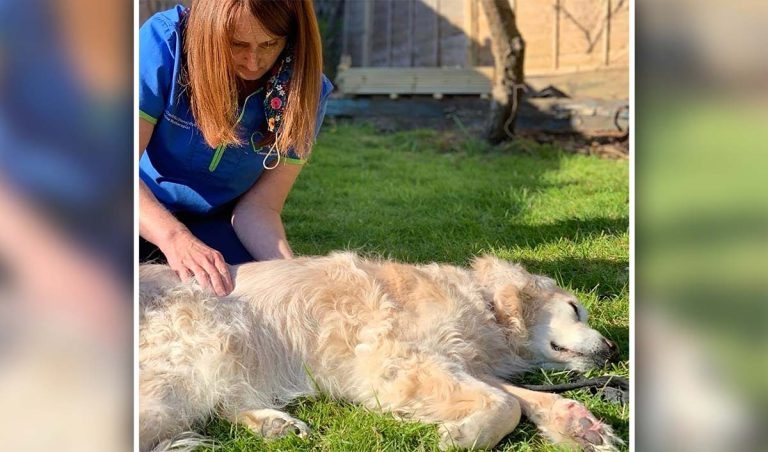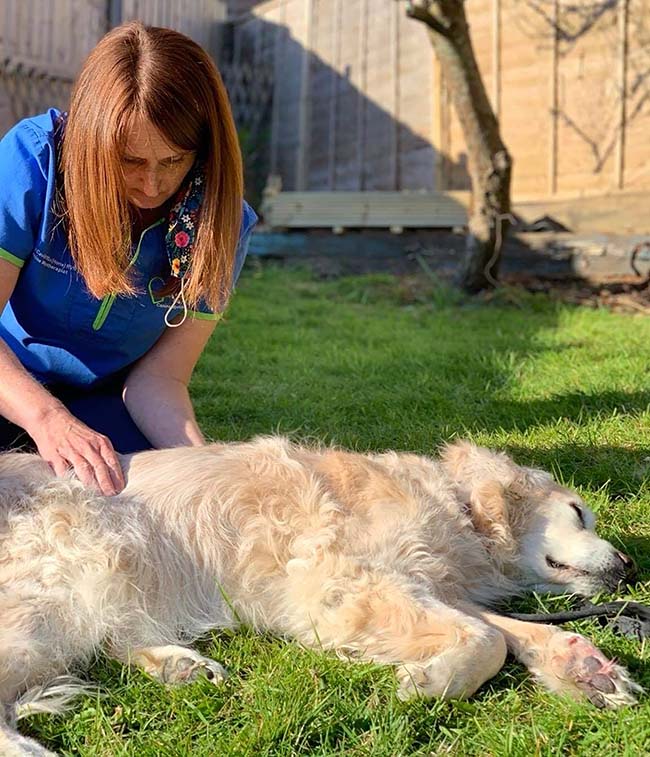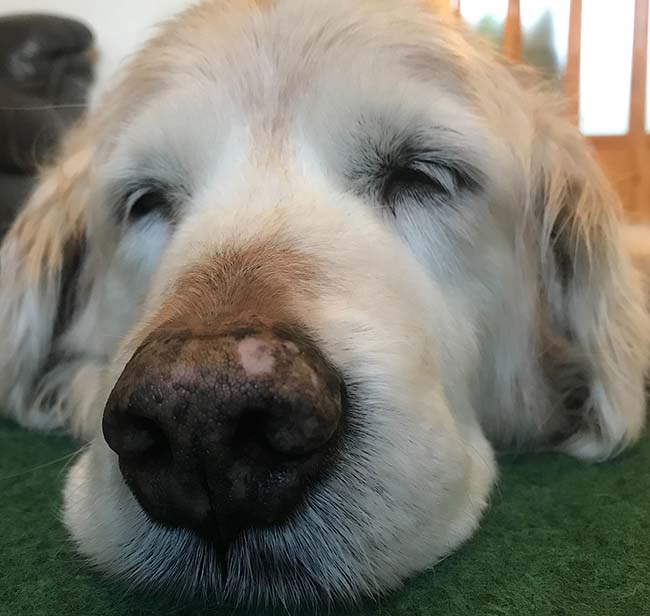1 Dec 2021
Breakthrough pain linked to OA in dogs
Kirsty Cavill explains how to identify and manage this type of abrupt affliction, which breaks through associated medications.

A multidisciplinary approach to managing canine OA includes referring appropriate cases to a qualified rehabilitation specialist in a timely manner.
The ability to experience pain is a trait common to all mammals, and the WSAVA Global Pain Council recognises the need to address and eliminate the pain incidence/pain treatment gap. Its vision is to develop “an empowered, motivated, and globally unified veterinary profession that effectively recognises and minimises pain prevalence and impact”.
OA is a common degenerative disease of synovial joints affecting up to 80% of dogs during their lifespan and resulting in progressive, pathological changes. OA affects the entire joint, including all associated soft tissue structures.
OA is the most common cause of chronic pain in dogs, which is also commonly associated with the development of additional soft tissue compensatory issues, myofascial trigger points – resulting in uneven weight loading – and an altered stance and gait.
The Canine Arthritis Management (2021) definition of OA is the following:
“Arthritis is the most common cause of chronic pain in dogs. It affects four out of five older dogs. It is a disabling, non-curable and progressive disease that initially focuses on moving joints, but eventually affects the whole dog and is a major cause of euthanasia due to loss of quality of life.”
What is breakthrough pain?
We know OA is an insidious beast, often resulting in both predictable and unpredictable flare-ups of symptoms and pain, but what exactly is breakthrough pain?
The WSAVA guidelines for recognition, assessment and treatment of pain (Mathews et al, 2014) define breakthrough pain as “an abrupt, short-lived and intense pain that ‘breaks through’ the analgesia that controls pain”.
The pain states associated with OA are often complex in nature, involving nociceptive and neuropathic mechanisms. Acute exacerbations of pain often occur, and new sources of pain can develop independently as part of the disease process. Chronic or maladaptive pain is representative of a malfunction in neurological transmission and serves no physiological purpose. Pain can become the primary disease and often leads to a polypharmacy treatment approach.
We should remain mindful that breakthrough pain is multifactorial in nature and often unpredictable. However, we can mitigate some of the controllable risks leading to breakthrough pain, helping to ensure we can achieve a higher quality of life (QOL) and health-related QOL (HRQoL), ensuring better overall patient outcomes.
HRQoL is a multidimensional concept relating to physical, mental, emotional and social functioning. Continued and regular episodes of flare-ups will aid to decrease overall joint health and increase the incidence of breakthrough pain.
Breakthrough pain affects every aspect of an animal’s life and often that of its owner, too. It can impact on the owner-vet relationship, medication compliance, patient outcomes, QOL and longevity.
It has been recognised owners will often experience anticipatory grief following their pet’s diagnosis, leading to a feeling of vulnerability, alongside the associated effects of caregiver burden. These emotions can be exacerbated when an owner regularly witnesses his or her pet struggling with pain or in distress. Therefore, reducing the occurrence of breakthrough pain will improve QOL and HRQoL for both the owner and the pet, alongside enhancing the client-vet bond.
How do we best assess, predict and control pain at each stage of the pet’s journey with OA?
The goal of any conservative treatment plan for the management of OA is to achieve effective pain management, improve QOL and slow down progression of the disease process.
Be proactive in your approach. How are you identifying pre-clinical cases of OA? Engage when the pet is young to help mitigate joint damage and afford the opportunity for early identification of cases.
However, when managing OA cases we know an evidence-based multidisciplinary treatment plan most often achieves the best outcome for the patient and, therefore, we can use our skill base in practice and the wider professional community to enable the development of a targeted and bespoke treatment plan for each patient. Bridging the gap in pain incidence therefore requires an educational approach encompassing all members of the veterinary team.

Know what you have available in your practice toolbox of treatment options, use timely referrals to specialists for rehabilitation therapy in conjunction with a pharmaceutical approach to manage pain levels and optimise appropriate mobility. Employ a multifactorial plan and reassess regularly.
When we adopt a proactive treatment approach, we can initiate pre-emptive and predictable pain management protocols.
Identifying breakthrough pain
OA is often referred to as the silent disease. Growing understanding exists of certain behavioural traits in dogs and cats that can be associated with the presence of chronic pain. By employing a proactive approach, we can more readily identify behavioural changes related to pre-clinical and clinical OA. Remember, age is just a number and not a reason why an animal is slowing down.
“Most canines do not vocalise their pain from arthritis and many pet owners do not believe their pet is in pain if it does not vocalise’’ (Fox and Millis, 2010). Therefore, we must adopt a stance of education to change this common misconception and improve our vigilance. Any change in behaviour can signal pain.

Identifying signs of chronic pain in dogs
Signs of chronic pain in dogs can include:
- decreased exercise tolerance
- less tolerant of interactions with dogs
- withdrawing from interactions with people
- changes in temperament
- change in sleep patterns – for example, pacing at night
- changes in eating habits
- stiff when/after getting up from a period of rest
- postural changes – hunched or roached back
- change in body profile – muscle atrophy
- hesitation going up steps or jumping into the car
- licking joints
- not wanting to be touched or groomed
- lameness – later stages
- pain elicited during a physical examination
Identifying breakthrough pain can be most effectively achieved by asking the right questions at the right time to enable the formation of an accurate patient profile. We must effectively communicate that the management of OA is a marathon and not a sprint. Timely check-ins between appointments and the use of structured questionnaires are effective in eliciting information to signpost patients experiencing breakthrough pain. Encouraging owners to keep a daily diary is an easy and proficient way to identify developing trends over time.
As professionals we need to align our language to improve owner understanding and overall compliance.
Mitigating breakthrough pain
Be proactive in your approach. By the effective use of skilled RVNs in clinic, we can improve owner understanding and overall compliance as an essential part of any OA management plan.
We need to include the owner at every step of the treatment plan, explain the rationale behind it, and check in regularly to ensure understanding and compliance. We need to invest our time to elicit a positive patient outcome and keep the owner on board with our treatment goals for his or her pet. This is achieved most effectively through the implementation of a coordinated whole practice approach, delivering a consistent message.
Avoid overwhelming the owner by targeting the most important information first – what is going to make the most difference in the least amount of time. Arrange timely check-ins between appointments. Set the expectation and be prepared to explain your rationale in the development of individual management plans.
We must, therefore, adopt a culture where we audit and assess treatment plans regularly and proactively to identify cases where the medication is not being given as prescribed, and then strive to understand the reasons behind this.
How many patients are falling through the gaps; only being given the prescribed medication when the owner feels their pet needs it or when they see their pet having a “bad day”? What barriers are these owners facing that are preventing them from following the treatment plan? Is the medication regime incompatible with their lifestyle and commitments?
How can we better support our clients? Regular case reviews will aid in achieving this goal. We must employ client-specific outcome measures, and use practice-consistent pain scoring and assessment tools.
We need to effectively convey the importance of lifestyle adaptations, the value of a targeted exercise plan, and weight management from an early stage in the pet’s life before clinical signs are apparent and irreversible damage had been done.
Named vet nurse teams can be effective in developing a bond of trust, respect and overall owner compliance. This is especially important for the assessment of pain and in identifying measurable change.
In terms of disease progression, we can often influence – but not prevent – the overall progression of OA by adapting lifestyle, diet and exercise management plans, and through regular monitoring and timely assessments of treatment management plans and medication protocols. We should be proactive in monitoring and reducing risk factors known to result in flare-ups, leading to breakthrough pain.
Weight management
Figures published by the BVA (2016) on World Obesity Day state that 60% of vets consider obesity to be the greatest health and welfare concern for pets in the UK.
A study by Pegram et al (2021) revealed 1 in 14 dogs are recorded by their vets as overweight each year and 7.1% of dogs under veterinary care were recorded as overweight in a single year.
It is recognised adipose tissue is a source of pro-inflammatory mediators, which could result in an overall increase in the inflammatory process and progression of the underlying pathology. Therefore, it stands to reason that we must encourage weight management and regular body condition scoring as part of a targeted treatment plan for canine OA.
Lifestyle
Identify exercise or lifestyle activities that are likely to initiate an inflammatory response:
- Inconsistent exercise regime – weekend warriors. Increased activity above what is normal for that pet can result in breakthrough pain in the following days.
- Torsional forces – sofa surfing, jumping in/out of the car and unsupervised access to stairs.
- Slippery floors – leading to frequent and repetitive micro-traumas.
- Repetitive exercises.
We need to be minimising activities that exert high torsional forces through the joint. We should be promoting regular and controlled exercise management plans, which are designed to encourage exercise consistency and even weight loading, while providing the necessary physical and mental levels of stimulation appropriate for the dog’s age and physical ability.
Medication review
Does the medication maintain an effective blood plasma level for the duration of its intended dose, or has progression of the disease process, or animal’s lifestyle, rendered the current medication less effective? Know what questions to ask and how to feed this back effectively into a patient case review with a named vet/nurse team.
Encouragement
Reflect regularly, and evaluate achievements and goals. Develop a next step plan and communicate this effectively with the owner in a timely manner.
Summary
Breakthrough pain is complex, and, therefore, demands an integrated multidisciplinary approach, where veterinary professionals work in cohesion to achieve the best possible patient outcome.
VNs are the vital conduit between pet, owner, vet and the wider professional team – and, therefore, play an integral role in the management of OA and breakthrough pain.
Top tips
- Don’t let your patients suffer in silence. Education is key in raising awareness, so employ a proactive approach.
- Employ a consistent, targeted and cohesive practice approach to identifying breakthrough pain, using timely assessments and consistent pain-scoring tools.
- Develop a practice toolbox of treatment options and owner-accessible resources.
- Strive to achieve client engagement, trust and compliance to ensure medication compliance and improve patient outcomes.
- Regular and structured case reviews.
